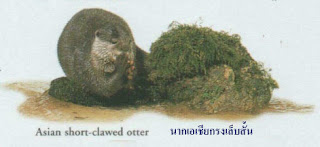BADGERS, OTTERS, AND
SKUNKS
THESE THREE GROUPS
OF ANIMALS are all members of the weasel family - Mustelidae. Their main characteristics
are a long, low-slung body, short legs, and
five toes on each foot. They are carnivores, although
badgers have a mixed diet. The
honey badger is especially fond of honey, as its name suggests. Most mustelids discharge a thick, oily, powerful-smelling fluid called a musk from their
anal glands. They use this mostly to send scent messages to other members of the species, usually with their
droppings.
|
ตัวแบดเจอร์
ตัวนาก และตัวเหม็น (สกังก์)
สัตว์สามจำพวกนี้อยู่ในตระกูลพังพอน
(weasel
family) วงศ์ Mustelidae มีลักษณะเด่น คือ มีลำตัวยาว
เอนลงต่ำ ขาสั้น และเท้าแต่ละเท้ามี 5 นิ้ว สัตว์สามจำพวกนี้เลี้ยงลูกด้วยนมและกินเนื้อเป็นอาหาร
แม้ว่าตัวแบดเจอร์จะกินอาหารผสมผสานกันก็ตาม ตัวฮันนี่แบดเจอร์น้ำชอบกินน้ำผึ้งเป็นพิเศษตามชื่อของมัน
สัตว์ตระกูลพังพอนส่วนใหญ่จะปล่อยของเหลว
เหนียว มีกลิ่นแรง ที่เรียกว่า musk (แปลว่า
กลิ่นรุนแรงจากสัตว์จำพวกนี้) จากต่อมที่อยู่ทางด้านทวารหนัก สัตว์เหล่านี้ส่วนใหญ่จะทิ้งกลิ่นไว้ในการสื่อสารกัน
|
|
Badgers
All badgers are
thick set with very powerful legs which
they use to forage for food and to dig their often extensive burrows. They are nocturnal animals, spending the day
underground with others of their social group. There are eight species of true badger,
plus the honey badger, which is classed in a sub-family of its own.
Eurasian badger
This is the largest badger and has the widest distribution. Females give birth to up to four cubs in February. These are weaned at 12 weeks, when they
can forage for themselves.
|
ตัวแบดเจอร์
ตัวแบดเจอร์ทุกตัวลำตัวหนามีขาที่ทรงพลังมากซึ่งใช้ในการหาอาหารและปกติจะขุดโพรงขนาดกว้าง
ตัวแบดเจอร์เป็นสัตว์กลางคืนตอนกลางวันจะอยู่ใต้ดินเป็นกลุ่มสังคม มีตัวแบดเจอร์อยู่
8 สายพันธุ์รวมทั้งตัวฮันนี่แบดเจอร์ซึ่งจัดอยู่ในตระกูลย่อย
ตัวแบดเจอร์ยูเรเซีย
ตัวแบดเจอร์พันธุ์นี้มีขนาดใหญ่ที่สุดและมีการกระจายพันธุ์มากที่สุด
ตัวเมียจะให้กำเนิดลูกถึง 4 ตัวในเดือนกุมภาพันธ์ ลูก ๆ เหล่านี้จะหย่านมเมื่ออายุ
12 สัปดาห์ เมื่อหาอาหารกินเองได้แล้ว
|
|
Paws
A Eurasian badger's
track is unmistakable. Each foot
has five toes with a kidney-shaped pad behind. The front claws usually leave marks because they are
long.
|
อุ้งเท้า
รอยของตัวแบดเจอร์ยุเรเชียจะปรากฏชัดเจน
แต่ละเท้าจะมีนิ้ว 5 นิ้ว มีส่วนนิ่ม ๆ คล้ายไตอยู่ด้านหลัง ปกติจะทิ้งรอยอุ้งเล็บด้านหน้าไว้เนื่องจากยาวกว่าด้านหลัง
|
Skull
A badger eats meat
and plants, and its large canines and broad molar teeth
are ideal for this diet. Its jaw
muscles are fixed to a rigid bone on the top of the skull, giving the animal a powerful bite.
|
กะโหลกศีรษะ
ตัวแบดเจอร์จะกินเนื้อและพืชเป็นอาหาร
และเขี้ยวขนาดใหญ่กับฟันกรามกว้างเหมาะสำหรับอาหารชนิดนี้ กล้ามเนื้อขากรรไกรติดแน่นกับกระดูกอันแข็งแกร่งที่ด้านบนของกะโหลกศีรษะ
ทำให้สัตว์ชนิดนี้มีพลังในการกัดอย่างมาก
|
|
Badger setts
During the day,
badgers live underground in a complex system
of tunnels and chambers called a sett. A main badger sett is easily recognized by
the entrances with piles of soil outside.
|
ถ้ำหรือโพรงของตัวแบดเจอร์
ในตอนกลางวัน
ตัวแบดเจอร์จะอาศัยอยู่ใต้ดินในอุโมงค์และห้องเป็นระบบสลับซับซ้อน เรียกว่า sett (ถ้ำหรือโพรง)
ถ้ำหรือโพรงหลักของตัวแบดเจอร์จะสังเกตได้ง่าย มีกองดินอยู่ที่ทางเข้าด้านนอก
|
Honey badger
The African honey
badger, also known as the ratel, has
a thick, loose skin. Predators can find it difficult to pierce its skin, and the badger can
twist around inside its skin and bite back.
|
ตัวฮันนี่แบดเจอร์หรือแบดเจอร์น้ำผึ้ง
ตัวฮันนี่แบดเจอร์แอฟริกา
จะเรียกว่า ratel
มีผิวหนังหนาหย่อน นักล่าสามารถค้นหามันได้แต่จะไชเข้าผิวหนังของมันยาก
และตัวแบดเจอร์สามารถหมุนตัวไปด้านในผิวหนังของมันและกัดตอบได้
|
|
Otters
These semi-aquatic mustelids occur outside the Polar Regions in every continent
except Australia. Some species are exclusively sea creatures, some use only fresh
water, and others use both sea and fresh water. Most have sleeping dens, or holts, on
land.
|
ตัวนาก
สัตว์ครึ่งบกครึ่งน้ำชนิดนี้เกิดอยู่นอกแถบขั้วโลกในทุกทวีปยกเว้นทวีปออสเตรเลีย
บางชนิดอยู่ในทะเลอย่างเดียว บางชนิดอยู่แต่ในน้ำจืดเท่านั้น
และบางชนิดอยู่ได้ทั้งในทะเลและน้ำจืด ส่วนมากจะหลับอยู่ในถ้ำเล็ก ๆ
หรือป่าเล็กบนเนินเขาบนบก
|
|||||
Paws
Although all otters
swim, not all have webbed feet. For example, the European otter has a large
amount of webbing. The Asian short-clawed otter has little webbing
and uses its paws to find food by
touch.
|
อุ้งเล็บ
แม้ว่านากทุกตัวจะว่ายน้ำได้
แต่ก็ไม่มีเท้าเป็นพังผืดทุกตัว ตัวอย่างเช่น นากยุโรป มีเท้าเป็นพังผืดขนาดใหญ่
นากเอเชียมีอุ้งเล็กสั้นมีพังผืดเล็ก ๆ และใช้อุ้งเล็บแตะหาอาหาร
|
Fur
An otter’s coat consists of two layers. A thick under-layer of fine
hairs traps air for warmth, and longer, waterproof guard hairs keep the underfur dry.
|
ขน
ผิวหนังของนากมีสองชั้น
ชั้นล่างมีขนนุ่มหนาสำหรับรับอากาศให้ความอบอุ่นและขนยาวป้องกันน้ำจะปกป้องขนชั้นล่างให้แห้ง
|
|||
Movement
With their long back
and heavy tail, otters can look clumsy
on land. In the water they are
graceful swimmers, propelling themselves
forward by moving their hindquarters and
tail up and down.
|
|||
การเคลื่อนไหว
เนื่องจากมีหลังยาวและหางหนา
นากจึงดูเหมือนเทอะทะเมื่ออยู่บนบก ในเวลาอยู่ในน้ำจะเป็นนักว่ายน้ำที่สง่างาม ผลักดันตัวเองไปข้างหน้าด้วยการเคลื่อนส่วนท้ายและหางขึ้นลง
|
|||
Spraints
Otters secrete a powerful scent. They mark their
territory by leaving their droppings, called
spraints, which smell of this scent, on high
points such as rocks.
|
มูลนาก
นากจะปล่อยกลิ่นรุนแรง
พวกมันจะทำสัญลักษณ์เป็นเขตแดนด้วยการปล่อยมูลของตัวเอง ที่เรียกว่า สเปรน ไว้
ซึ่งกลิ่นนี้จะอยู่บนจุดที่สูง เช่น ก้อนหิน เป็นต้น
|
||
Skunks
There are 13 species
of skunk, which all occur in the Americas.
They are best known for their ability to squirt a
foul-smelling fluid from their anal
glands. They aim this fluid at the eyes of
an enemy, and it can cause temporary blindness. Skunks search for insects and other
small animals to eat, mainly at night.
ตัวเหม็นหรือตัวสกังก์
ตัวเหม็นหรือตัวสกังก์มีอยู่ 13
สายพันธุ์ ทั้งหมดเกิดในทวีปอเมริกา ตัวสกังก์รู้จักกันดีในความสามารถพ่นของเหลวที่มีกลิ่นเหม็นออกจากต่อมที่ทวารหนักของมัน
มันจะพุ่งของเหลวนี้ไปที่ตาของศัตรู และสามารถทำให้ตาบอดชั่วคราวได้ ตัวสกังก์จะค้นหาแมลงและสัตว์เล็ก
ๆ ชนิดอื่นเป็นอาหาร ส่วนใหญ่จะออกหากินในเวลากลางคืน
|
||||
Markings
Skunks have bold black and white coat markings. Like the yellow and black
stripes of a wasp, these warn would-be predators of danger.
|
ลาย
ตัวสกังก์จะมีลายขนดำและขาวเป็นริ้วหนาอยู่บนลำตัว
คล้ายกับลายเหลืองและดำของตัวต่อ ลายเหล่านี้จะเตือนอันตรายสัตว์ที่ต้องการจะล่าพวกมัน
|
|||
|
EURASIAN BADGER
|
|
|
ตัวแบดเจอร์ยูเรเซียน
|
|
|
SCIENTIFIC NAME:
|
Meles
meles
|
|
ชื่อวิทยาศาสตร์:
|
Meles
meles
|
|
ORDER:
|
Carnivora
|
|
ลำดับ:
|
Carnivora
|
|
FAMILY:
|
Mustelidae
|
|
วงศ์:
|
Mustelidae
|
|
DISTRIBUTION:
|
Europe
and a wide band across Asia
|
|
การกระจายพันธุ์:
|
ทวีปยุโรปและกระจายเป็นวงกลมทั่วทวีปเอเชีย
|
|
HABITAT:
|
Mainly
lowland farmland and woodland
|
|
ถิ่นที่อยู่อาศัย:
|
ส่วนใหญ่อยู่บริเวณที่ราบ
ที่ทำเกษตรและป่าไม้
|
|
DIET:
|
Worms, insects,
birds, and other small animals, fruit, cereals, fungi
|
|
อาหาร:
|
ตัวหนอน
แมลง นก และสัตว์เล็ก ๆ ชนิดอื่น ผลไม้ พืช จำพวกข้าว เห็ดรา
|
|
SIZE Length:
|
1 m (3.3 ft)
|
|
ขนาดความยาว:
|
1
เมตร (3.3 ฟุต)
|
|
LlFESPAN:
|
About 7
years
|
|
อายุขัย:
|
ประมาณ
7 ปี
|













